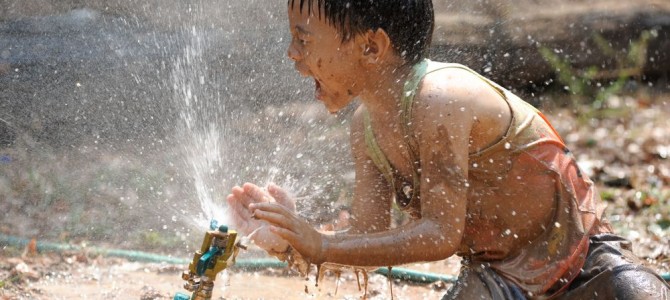
“Roll out those lazy, hazy, crazy days of summer. The days of soda, and pretzels and beer. — Nat King Cole
Summer is finally here—and every parent, child, and school teacher said “Amen.” Except education officials who reduce recess or advocate for year-round school, because they think the dog days of summer, full of slip n’ slides, vacation, bike rides, and popsicles, are a waste of time. Yet research shows play is learning, and summer time demonstrates this perfectly.
Last year at least 23 schools in Orange County, Florida, cut recess down to mere minutes or axed it altogether so kids had more time in classrooms. This is due in part to the slow implementation of the Common Core curriculum and the fact that students weren’t performing as well on standardized tests as school officials wanted.
The decline of active recess time was, however, going on even before Common Core implementation heightened officials’ frenzy for better test results. “Public schools throughout the United States continue to reduce the amount of time allotted to free play. For example, in response to No Child Left Behind, many schools increased their focus on reading and math by decreasing the amount of time allocated to recess and the creative arts. Ironically, play helps children adjust to school and improves their readiness to learn.”
Nearly all states allow local districts to operate schools year-round. Most of them do in some fashion, for at least the children slotted for summer school because of poor performance during the typical academic year. Year-round school also affects the play time most kids enjoy. While there are certainly some benefits to year-round school (especially for people who homeschool due to frequent travel or being in a military family) such as keeping kids sharp and not having to review material they’ve forgotten over the summer, it seems to ignore, if not altogether erase, the magic of a playful, fun, slip-n-slide-in-the-back-yard summer.
A popular strategy for kids where I live near Washington DC is for parents to send their kids to expensive, minute-by-minute structured summer camps—nearly every week of the summer! Costs for these camps range from $200 per week to $1,300 per week. While summer camp is great and some parents are forced to do this due to work schedules, filling a child’s entire summer with pre-planned activities at a mind-boggling rate does children no favors. Whatever happened to spontaneously setting up the sprinkler and running through it?
What Play Does for a Child
Don’t you remember your childhood full of hours agonizing over math, book reports, and spelling tests? I don’t—at least not much. From my childhood, what I do remember is an hour on the playground in the beaming sun during recess, making up games with my friends, playing spontaneous rounds of kickball (I was neither first nor last to get picked, if you must know) and weeks upon weeks of flag football during chilly Minnesota fall months. Nostalgia doesn’t make the case for play alone (although it might mean something?) but there are certainly benefits to free, unstructured play, both during the school year and in summer, well beyond what any textbook, teacher, or parent can facilitate.
The American Academy of Pediatrics says “Play is essential to development because it contributes to the cognitive, physical, social, and emotional well-being of children.”
It’s free-play that gives students the opportunity to develop social competence. “During these times, they not only rest and recharge—they also learn to cooperate, communicate, and compromise, all skills they need to succeed academically as well as in life.”
Tim Walker was an American who taught for a time in Finland, which is home to the top-performing public education system in the world. He wrote about his experience in The Atlantic in 2014, particularly how the Finnish let the students have 15 minutes of unstructured play following every 45 minutes of learning.
“Once I incorporated these short recesses into our timetable, I no longer saw feet-dragging, zombie-like kids in my classroom,” he said. “Throughout the school year, my Finnish students would—without fail—enter the classroom with a bounce in their steps after a 15-minute break. And most importantly, they were more focused during lessons…At first, I was convinced that I had made a groundbreaking discovery: frequent breaks kept students fresh throughout the day. But then I remembered that Finns have known this for years; they’ve been providing breaks to their students since the 1960s.”
Consider the Perspective of a Child
The problem with Common Core, year-round school, thousands of dollars on summer camps, and overpriced vacations to Disney World (don’t hate!) is we tend to view all this from the perspective of an adult, because we know better, with our adult minds, our adult ways, and our adult energy. But—surprise!—being a kid isn’t about being an adult.
What encourages and develops a child’s mind and body isn’t what does the same for us. Adults don’t necessarily need a 15-minute break every 45 minutes, although some research recommends that as an excellent work strategy for top performance. If it works for the world’s top school system and for top-performing adults, maybe it’s a good idea more people in charge of kid time should consider.
This doesn’t mean kids rule the roost and should sit poolside eating ice cream all day. Adults create safety parameters and guidelines for reasons. But “Boys will be boys” and “You’re only a kid once” are catchphrases that carry great meaning. If an imaginative, supportive, adaptable childhood is the gateway to a healthy adulthood, why are we forcing children into adulthood early by cutting off one of the lifelines to the qualities we are trying to foster?









